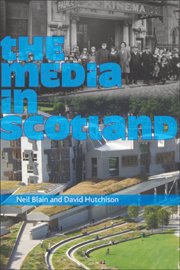Book contents
- Frontmatter
- Contents
- Preface
- Framing the Discussion
- The Historical Context
- Screen and Sound
- Themes and Futures
- 12 Gender, Spaces, Changes: Emergent Identities in a Scotland in Transition
- 13 Race and Ethnicity in the Media
- 14 Gaelic, the Media and Scotland
- 15 The Scottish Media and Politics
- 16 A View from Westminster
- 17 A View from Holyrood
- 18 Media Sport
- Select Bibliography
- Notes on Contributors
- Index
12 - Gender, Spaces, Changes: Emergent Identities in a Scotland in Transition
from Themes and Futures
Published online by Cambridge University Press: 05 August 2013
- Frontmatter
- Contents
- Preface
- Framing the Discussion
- The Historical Context
- Screen and Sound
- Themes and Futures
- 12 Gender, Spaces, Changes: Emergent Identities in a Scotland in Transition
- 13 Race and Ethnicity in the Media
- 14 Gaelic, the Media and Scotland
- 15 The Scottish Media and Politics
- 16 A View from Westminster
- 17 A View from Holyrood
- 18 Media Sport
- Select Bibliography
- Notes on Contributors
- Index
Summary
Scotland, in common with many small or stateless nations, has struggled with its history and identity. Representation, whether on page, stage or screen, has played a crucial role in that struggle. There are two key trends in the construction of Scottish identity which can be seen as particularly problematic in terms of representations of gender: firstly, the turn to a static past as the guarantor of separate identity (McArthur 1982; Craig 1996); and secondly, the search for a single, unified national identity, whose emphasis on masculinity sees femininity relegated to a supporting or symbolic role, and which neglects to account for other kinds of diversity.
Our analysis focuses on the moving image and predominantly on fictional narratives, arguing that this is the key cultural ground where ways to imagine and re-envisage identity are explored. This chapter makes no pretence to be comprehensive in its references, but signals some of the emerging processes that offer new models of gendered approaches to a nation in transition, despite continuing limitations. In this chapter we identify dominant trends, and traces of alternative imaginings. We pay particular attention to the representation of historical change, arguing that gendered representations play a highly symbolic role as bearers of moments of transition, as well as functioning in more traditional ways as markers of ossified difference, whether national or gendered.
- Type
- Chapter
- Information
- The Media in Scotland , pp. 183 - 198Publisher: Edinburgh University PressPrint publication year: 2008



